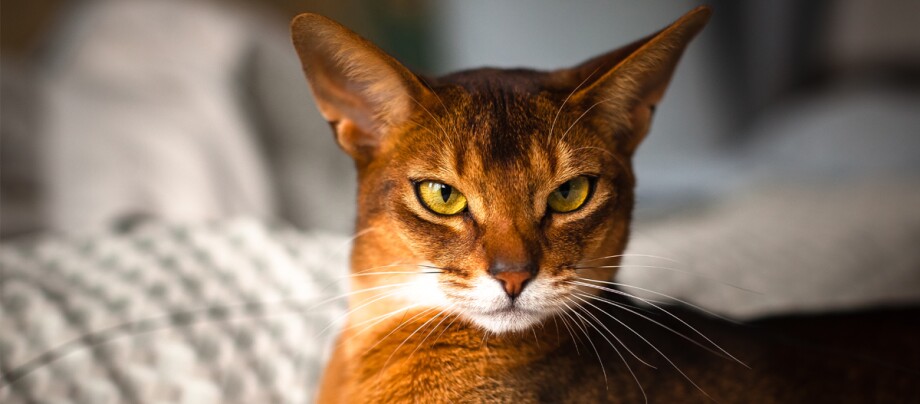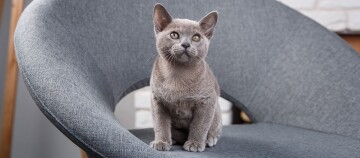Abyssinian Cats – Talkative Companions with an Elegant Appearance
07.10.2022 - Reading time: 3 minutes

The Abyssinian is impressive for its agility and curiosity. Moreover, the beautiful cat with its special coat colouring proves to be extremely sociable and affectionate towards people, conspecifics and also other animals. If you want an active and elegant cat as a family member, an Abyssinian is an excellent choice.
NewsletterAbyssinian cat
Breed | Abyssinian |
Origin | Near-Eastern cat |
Size | medium-sized, head-torso length about 60 cm |
Weight | 3 to 3.5 kg (female cat), 4 to 5 kg (tomcat)
|
Physique | muscular but slender, long legs, long tail |
head shape | wedge-shaped head; soft contours; large ears, broad at the base; medium-length nose |
Eyes | green, yellow, amber coloured
|
Coat and colour | Ticking, Ruddy colours, Blue, Fawn and Sorrel |
Coat care | occasional brushing
|
Nature | curious, agile, sociable, affectionate, intelligent
|
Special features | softer voice than other Orientals
|
Owning | not as a single cat, ideally with a secure outdoor area |
Abyssinian cat: nature
The beautiful Abyssinian resembles a miniature puma and displays many typical characteristics of oriental cat breeds: it is playful, curious and very attentive. It is very active and needs sufficient mental and physical activity. It exercises its vitality particularly well with other cats – and also with dogs, provided they have become gradually accustomed to each other. Thanks to its outgoing nature including towards children, it proves to be a wonderful family cat. Nevertheless, it is not just a cuddly kitty. It enjoys experiencing and discovering new things.
Abyssinian cat: keeping and care
The Abyssinian is actually quite an easy cat to care for, provided you provide enough entertainment in the form of play, clicker training and other activities. The intelligent and curious Asian cats constantly need new, exciting toys to challenge both mind and body. Climbing and hiding places as well as scratching trees are vital to enable the animals to fulfil their urge to play and move. A well-secured balcony or garden is also ideal for romping and playing.
Abyssinians love company – of other cats, people and also other animals. Given their sociability, it is definitely not a good idea to keep them alone in your home. Abyssinian cats feel perfectly at ease as a member of a family together with children, other cats or a dog.
Abyssinian cat: colours
Abyssinians exhibit a unique coat colouration, which is referred to as “ticking”. In the case of Abyssinians, ticking describes a two- to fourfold banding of the hair. This coat pattern, also called the “agouti effect”, is similar to that of wild hares. However, ticking does not affect the entire coat, but only the head, the outside of the legs, the tail and the back. The other parts of the body have a uniform basic tone.
The only colours accepted in the breed are those derived from the colour pigment “eumelanin”, which ensures strong light absorption and thus produces a dark pigmentation. All ruddy colours as well as blue, fawn and sorrel are accepted for breeding. To date, chocolate and lilac are not recognised by all breeding associations.
Abyssinian cat: History
There are numerous legends surrounding the history of the Abyssinian. One of them originates from the name, which suggests that the cats came from Abyssinia, today’s Ethiopia. Another theory states that Abyssinian cats are the descendants of animals revered in Egypt. Both stories are false.
Genetic research has shown that the distinctive markings on the fur of Abyssinians only appear in wild cats in a certain area on the coast of the Indian Ocean between Sri Lanka and Singapore. This suggests an origin in this region. Traders brought the animals from the Near East to Africa, where they reached Europe with British troops in 1868. Abyssinians have been a recognised breed since 1882, which makes them one of the oldest pedigree cats in Europe.
Abyssinian: Special features
If you are looking for an oriental cat, but do not particularly like their loud vocalsations (like Siamese cats), the Abyssinian could be the right family member for you: Abyssinians do like to “talk” to their human companions, but they do so in a somewhat soft and gentle animal voice.




